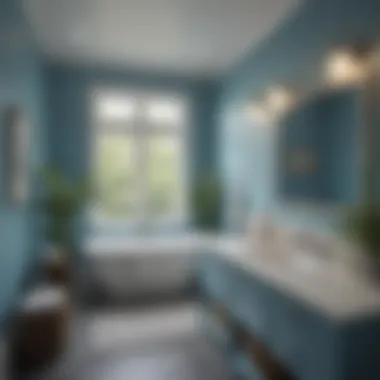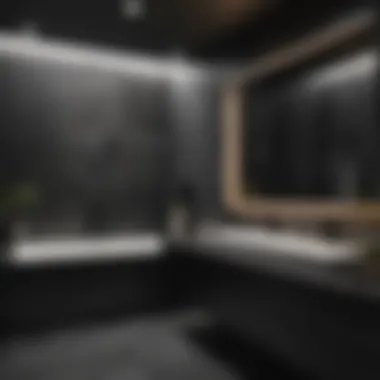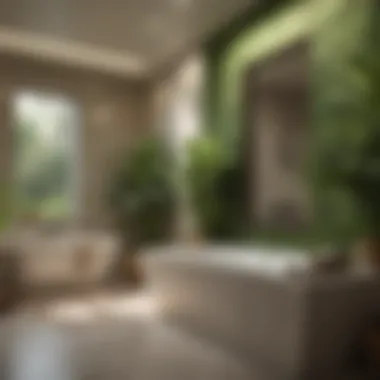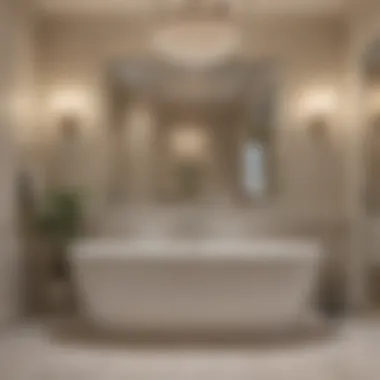Master Bath Paint Colors: Selecting the Perfect Palette


Intro
When thinking about your master bathroom, color may be the last thing that comes to mind. However, paint colors play a crucial role in defining the mood and functionality of the space. From soothing blues to energizing yellows, each hue affects emotions differently, making it important to choose wisely. This connection between color and atmosphere is explored deeply in this guide. Here, you will understand how to select the most suitable colors based on your design aspirations and practical needs.
The relationship between color and psychological response is significant. A dark, bold red may evoke passion yet can feel overwhelming in a small bathroom. On the other hand, softer shades like pastel greens or light grays often create an inviting environment. You will discover trends in color palettes while also recognizing classic choices that endure over time.
Next, we will explore design inspiration tailored for your master bath. Following that, you will find practical tips for maintaining your paint and budgeting for your project. Let's delve into the creative process that leads to selecting the right colors for your unique space.
Understanding Color Theory
Color theory is fundamental when it comes to selecting paint colors for master baths. It encompasses how colors interact, how they can affect moods, and how they can influence the perception of a space. Utilizing color theory appropriately allows homeowners and designers to create a harmonious and inviting atmosphere. By understanding the basics of color perception and the emotional impact of color, one can make informed decisions that align with personal style and functional needs.
The Basics of Color Perception
Color perception refers to how individuals see and interpret colors. It can often vary from one person to another. The three primary colors are red, blue, and yellow. By mixing these colors, secondary colors emerge, such as green, orange, and purple. When selecting a paint color for a master bath, consider how these colors blend and contrast with each other and existing features. Moreover, the way light interacts with color is crucial. Natural light can alter a color's appearance throughout the day, affecting how a room feels.
The Emotional Impact of Color
Warm vs. Cool Colors
Warm colors such as reds, oranges, and yellows tend to create an energetic vibe. They can make a space feel cozy and inviting but can also stimulate energy. In contrast, cool colors like blues, greens, and purples often evoke calmness and relaxation. Choosing between warm and cool colors often depends on the desired atmosphere in the master bath. A warm color palette might be beneficial if one aims to create a lively, warm environment.
This choice can thereby encourage activities like relaxing baths or reviving morning routines. However, a cool palette can be ideal for those looking for a serene retreat.
Neutrals: Balancing Act
Neutrals such as whites, greys, and beige are versatile choices. They provide a balanced background that works well with other colors. When considering a master bath, these colors can easily complement various fixtures and materials. Neutrals can be both calming and elegant. They have the advantage of allowing flexibility in design, as they pair well with bold or bright accents. However, using too many neutrals without any pops of color can create a bland atmosphere.
Accent Colors: Making a Statement
Accent colors serve the purpose of drawing attention and adding depth to a space. These colors can be used on walls, fixtures, or decor elements to create a focal point. For example, a deep blue accent wall can provide contrast against lighter hues in a master bath. This choice can bring depth to an otherwise flat color scheme. Accent colors can invigorate the overall design and can be tailored to express individuality through style. Selecting too many contrasting accent colors, however, might create visual clutter, so a thoughtful application is essential.
Choosing Colors for Small Spaces
Color selection for small bathrooms requires careful consideration. Lighter colors can give an illusion of space, making the area feel larger than it is. Utilize pastel shades and cool colors to enhance this effect. Alternatively, using darker tones can create a moody environment; just be cautious as it may make the space seem smaller.
Consider adding stripes or patterns to create a sense of height and prevent the space from feeling cramped. Additionally, strategically placed mirrors can enhance light and reflect color, further improving perception.
Understanding color theory not only aids in selecting appealing colors but also assists in achieving a desired mood and maximizing spatial awareness. This knowledge serves as a valuable tool for enhancing the ambiance of any master bath.
Assessing Your Master Bath's Features
When selecting paint colors for a master bath, it is crucial to assess the unique features of the space. Each bathroom has its characteristics that influence color choice. Recognizing these can enhance both function and aesthetics. From lighting to existing materials, understanding these elements will shape how colors interact within the space.
Natural Light Considerations
Natural light significantly impacts how colors appear in any space, especially bathrooms. A room with abundant natural light often allows for bolder colors. Conversely, spaces with limited light might benefit from lighter hues to create brightness. The direction of the light helps as well; east-facing rooms often receive warm morning light, while west-facing rooms get cooler evening tones.
Existing Fixtures and Materials
Choosing paint colors should consider existing fixtures and materials within the bathroom. They provide a base palette that can facilitate harmonious design.
Vanity Styles
Vanities are typically premium features in any master bath. Their style can set the tone for the space. A modern vanity with clean lines may blend well with chic, bold colors. Meanwhile, traditional vanities pair nicely with softer, muted tones. The key characteristic of vanities is their material. Wooden vanities exude warmth, while sleek metal options convey a contemporary feel. Balancing these attributes is essential to ensure that paint selections feel coordinated. The disadvantage is that an incompatible color may clash with the vanity.
Flooring Choices
The flooring in a master bath plays an important role as well. Whether it's tile, wood, or vinyl, the flooring color and pattern create a visual foundation. Light-colored floors may help to brighten a smaller bath but may show stains easily. Darker floors, while grounding, can make a space feel more compact. It is beneficial to consider how the chosen paint interacts with the existing floor color to maintain coherence.


Tile Colors and Patterns
Tile colors and patterns are significant design aspects in a master bath. They can either complicate or simplify the color palette. A bold tile pattern may invite more neutral paint choices to avoid clashing. On the other hand, simple tile designs allow for experimentation with vibrant wall colors. The unique feature of tile lies in its texture and finish, which can reflect light differently than paint, adding depth to the design. This interplay can enhance visual interest, but one must ensure that the overall appearance doesn't feel overcrowded.
Space Layout and Design
The layout and overall design of the bathroom also guide color selection. Open layouts may be suitable for more adventurous color choices, as the space feels expansive. In contrast, compact layouts might benefit from lighter colors to give an illusion of more space. It is essential to evaluate how the chosen colors will enhance or detract from the existing layout. Thus, thoughtful consideration in this area will yield a more pleasing aesthetic in the finished master bath.
Current Trends in Master Bath Paint Colors
The choice of paint colors in a master bathroom is an essential factor that contributes to the overall ambiance, functionality, and aesthetic appeal of the space. Observing current trends allows homeowners and designers to stay relevant and innovative. By understanding these trends, they can create environments that are both relaxing and stylish. This section explores how soft pastels, bold hues, and dark shades are making waves in master bath design. These trends offer a range of benefits, from enhancing personal style to maximizing spatial perceptions.
Soft Pastels: A Calm Retreat
Soft pastel colors, such as blush pink, mint green, and pale lavender, are particularly in demand for master bathrooms. They evoke a sense of tranquillity and relaxation, which is vital in a space meant for self-care. The subtle tones can visually enlarge a smaller room and reflect light beautifully, thereby contributing to a bright and airy atmosphere. Additionally, these colors facilitate a palatable backdrop for various decorative elements, ensuring a harmonious look.
Benefits of Using Soft Pastels:
- Creates Serenity: Soft hues can reduce stress and create a calming environment.
- Enhances Natural Light: These colors can amplify light reflection.
- Versatile Combinations: Soft pastels pair well with other colors, such as soft whites or deeper tones forアクセント.
Bold Hues: Making a Statement
As an opposing trend, bold colors are gaining popularity in master bathrooms. Vibrant blues, fiery reds, and deep greens can serve as impactful statement colors that draw attention. These hues can inject life and energy into the space, making it feel unique and personalized. Although bold colors demand careful consideration in terms of balance and décor, they provide an opportunity for homeowners to express their individuality.
Advantages of Bold Colors:
- Personality: Bold hues showcase the homeowner’s unique style.
- Strong Visuals: Creates a focal point that captures attention.
- Energetic Vibe: Infuses the room with energy, making it stimulating.
Dark and Moody: Creating Depth
Another trend is the use of deep and moody colors, such as navy blue, charcoal gray, and deep green. These shades create depth and can add a layer of sophistication to any master bath. Used strategically, they can make a space feel cozy while providing a modern edge. Dark colors can also evoke a sense of intimacy, transforming the bathroom into a luxurious retreat where one can escape the stresses of daily life.
Key Considerations for Dark Shades:
- Contrast: Pair with lighter elements to avoid overwhelming the space.
- Lighting: Ensure adequate lighting to balance the dark tones, enhancing visual appeal.
- Texture: Use varied textures to add interest to the dark colors, making the space feel more dynamic.
Current trends in master bath paint colors reflect ongoing shifts in design philosophies, emphasizing individuality while maintaining comfort.
Timeless Color Choices for Master Baths
Selecting timeless colors for your master bath is crucial for creating a space that remains aesthetically pleasing over time. Timeless colors have a lasting appeal. They are less prone to going out of style compared to more trendy choices. By choosing wisely, you can ensure that your bathroom maintains its elegance for many years to come.
Consideration of natural light and existing fixtures will also play a role in determining these classic hues. These shades can help create a harmonious look that complements various design elements, from fixtures to flooring. In the following sections, we will explore a few ideal color choices that exemplify timelessness.
Classic Whites and Off-Whites
Classic whites and off-whites are foundational colors in master bath design. They often symbolize cleanliness and simplicity, giving the illusion of larger spaces. Whites reflect light well, which is essential for a room that may not have ample natural light. Off-whites introduce a touch of warmth, helping to create a welcoming environment.
Key benefits of these shades include:
- Versatility: They pair easily with other colors and styles.
- Timeless appeal: White never goes out of fashion.
- Easy maintenance: Dirt and stains are clearly visible, encouraging cleanliness.
However, selecting the right undertone is important. Some whites lean too warm and may clash with cooler tones in your fixtures. Testing samples on your walls is recommended.
Greys: Versatile and Modern
Greys have risen to prominence in recent decades as a versatile and modern choice for bathrooms. The color grey offers sophisticated elegance, adapting well to various styles, from minimalist to traditional. Its range spans from light, silvery tones to darker, charcoal shades.
By using grey, you can:
- Create a serene environment: Lighter greys provide tranquility.
- This shade can act as a backdrop: It highlights other elements like tiles or art.
- Balance other colors: Grey pairs well with both warm and cool tones.


It’s essential to choose the correct grey for your space. Testing different shades in various lighting conditions will help you find the right fit.
Earthy Tones: Grounding Spaces
Earthy tones such as soft browns, greens, and terracotta are predictable yet reliable choices for any bathroom. These colors resonate with natural elements and often make the space feel grounded and organic.
Using earthy tones, you can:
- Establish a connection to nature: Earthy colors can feel comforting.
- Blend with organic materials: Such as wood and stone.
- Achieve a warm atmosphere: They help balance cooler fixtures and tiles.
These hues can offer a calming effect, perfect for a relaxing retreat. Earth tones enhance your master bath's ambiance while ensuring longevity in design.
Choosing the right timeless colors means thinking about the long term. This is especially relevant for investment spaces like master baths where renovations can be costly and time-consuming.
In summary, timeless color choices can lead to a harmonious and stylish master bath. By selecting classic whites, versatile greys, or earthy tones, homeowners create an inviting and lasting atmosphere.
Special Considerations for Bathroom Paint
Choosing paint for a master bathroom involves unique challenges. The bathroom's environment, with its high moisture and varying temperatures, requires careful thought regarding the types of paint used. This section addresses crucial aspects of selecting paint that not only enhances the beauty but also withstands the bathroom’s special conditions. The benefits of making informed choices in this area can lead to a lasting finish and an appealing atmosphere, making the process of selecting paint more significant than one might initially assume.
Choosing the Right Finish
Selecting the correct finish impacts both the aesthetic appeal and durability of bathroom paint. Different finishes serve varied purposes and are suitable for specific contexts, especially in damp areas.
Matte vs. Satin
Matte finishes give a rich, flat look to walls, providing excellent coverage and hiding imperfections. However, they can be challenging in a bathroom setting because they are less wash-resistant. In contrast, satin finishes offer a soft glow and are more resistant to moisture, making them a practical choice.
Choosing between matte and satin often depends on the desired visual outcome and practical application. Satin’s sheen allows for easier cleaning, which is critical in a moisture-heavy environment. It resists stains better than matte, hence its popularity in bathrooms. However, if a smooth, flawless look is essential, matte can still be considered with the understanding that it may require more maintenance over time.
Semi-Gloss for Durability
Semi-gloss finishes combine the best aspects of both matte and satin. They are incredibly durable and water-resistant, which makes them an excellent choice for areas prone to humidity. This finish can withstand frequent cleaning and is often resistant to mold and mildew, a consideration that is vital for bathrooms.
A semi-gloss finish will reflect light, adding an element of brightness to the space, but it can highlight surface imperfections more than its matte counterparts. Thus, proper wall preparation becomes essential before applying this type of paint. Its durability often justifies its selection, making it a preferred choice for many homeowners.
Moisture-Resistant Paints
Moisture-resistant paints are specifically formulated to withstand the high humidity levels found in bathrooms. This type of paint, often labeled as bathroom paint, is designed to prevent mold and mildew growth, enhancing the longevity of the finish. When selecting paints, it is crucial to prioritize those with anti-mold properties, ensuring the bathroom remains a safe and healthy environment.
Choosing moisture-resistant paints often leads to longer-lasting results. They prevent peeling and fading, which can be particularly problematic in moisture-prone areas. The additional care to select these paints reflects a commitment to maintaining both beauty and functionality in the bathroom.
Preparation for Paint Application
Proper preparation is crucial before applying paint. This phase determines the overall finish and appearance of the painted surface.
Surface Cleaning
Surface cleaning is a fundamental step in the preparation process. Before any paint is applied, walls must be free of dirt, grease, and grime. This ensures optimal adhesion of the paint to the surface.
Using a mixture of soap and water helps to remove any surface contaminants, making it a necessary step. Neglecting surface cleaning can lead to unsightly peeling and bubbling down the line, which undermines the painting effort. The importance of this simple process cannot be overstated, as it significantly affects the paint's durability and finish.
Priming Essentials
Priming is often an overlooked aspect of painting in bathrooms. A good primer improves paint adhesion, providing a more uniform appearance once the final color is applied. Specifically, mildew-resistant primers are optimal for bathrooms, as they offer additional protection against mold growth.
Using primer can extend the life of the paint job, especially in humid environments. It creates a barrier, sealing the pores of the surface, which helps the topcoat to adhere more effectively. This preparatory step elevates the quality of the final outcome, making it worth the slight extra effort before painting begins.
Personalizing Your Master Bath
Personalizing a master bath is an essential part of creating a space that truly reflects your taste and lifestyle. This area should not only be functional but also an extension of your personal style. It is significant to consider how the selected colors and decor can manifest your identity and create an inviting atmosphere. Personalization entails integrating your preferences and unique elements into the design, thus making the space feel like your own.


When you think of personalizing your master bath, it involves more than just choosing a paint color. Each element, from the hues on the walls to the accessories, speaks to who you are. The benefits of personalization are manifold; it can enhance comfort, aid relaxation, and even increase the functionality of the space based on how you use it.
Integrating Personal Style
Client's Preferences
Understanding client's preferences is vital in defining the look and feel of the bathroom. This concept incorporates the specific styles, colors, and functionalities that the client desires. A focus on client's preferences ensures the design aligns with their vision and everyday needs.
Key characteristics of this approach are flexibility and attentiveness to detail. When a homeowner expresses a specific desire for particular colors or aesthetics, this preference becomes the focal point of the design. For example, a preference for earthy tones can lead to a calming environment that promotes relaxation.
The unique feature of prioritizing client's preferences is the establishment of a deeply personal space. The advantages include a greater connection to the bathroom, making it a sanctuary rather than just a utilitarian area. However, one disadvantage may arise if all preferences are not well-balanced with practical aspects, such as lighting and space limitations.
Incorporating Artwork
Incorporating artwork into bathroom design contributes significantly to the overall atmosphere. Art can serve as a meaningful element that adds character and depth to the space. The presence of artwork can transform a simple bathroom into a stunning showcase of creativity.
A notable aspect of using art is its ability to reflect personal stories and experiences. Therefore, selecting pieces that resonate emotionally can enhance the soothing environment of a master bath. Choosing artwork in complementary colors to the chosen palette can create a cohesive and vibrant look.
The distinctive feature of incorporating artwork lies in its capacity to create focal points. Art can provide texture and visual interest, making the room feel completed. However, it is important to consider the safety and durability of the selected materials, as not all art pieces may be suited for high-moisture environments.
Creating a Cohesive Look
Establishing a coherent aesthetic in the master bath is critical for visual harmony. This involves selecting colors and materials that work together to form a unified look. Every element, from the paint to the accessories, should complement each other to enhance the experience.
Designing with a cohesive look can often mean choosing a specific theme or color scheme that will guide decision-making for every element. This simplification can yield a more polished and sophisticated appearance.
Incorporating Accessories
Towels and Textiles
Towels and textiles serve as functional yet impactful accessories in the master bath. They not only provide practicality, but they also add layers of texture and color. The selection of these items can greatly influence the overall aesthetic.
A key characteristic of towels and textiles is their versatility; they can be easily changed or updated without significant alterations to the overall design. For instance, seasonal colors or patterns can refresh the look with minimal cost and effort.
The advantage of well-chosen textiles is their ability to evoke a certain mood. Luxurious fabrics can direct the ambiance towards relaxation, while bright patterns can energize the area. One must, however, ensure that the materials chosen are moisture-resistant and easy to clean, keeping practicality in mind.
Decor Elements
Decor elements, including vases, trays, or plants, add layers and personality to the bathroom design. These small items often serve as finishing touches that contribute significantly to the overall atmosphere. Selecting the right decor elements can help bridge the gap between aesthetics and functionality.
The central attribute of decor elements is their ability to personalize the space further. This creates an opportunity for homeowners to showcase their unique style through the choice of decor.
The unique feature is how decor can be updated or changed without major renovations. This flexibility allows homeowners to explore new styles or trends over time. However, an overabundance of decor can lead to a cluttered look, so careful selection is key.
Final Thoughts
In concluding this exploration of master bath paint colors, it is essential to recognize the significant impact that color selection has on the atmosphere and functionality of this intimate space. A master bath is more than merely a utility area; it serves as a sanctuary for relaxation and rejuvenation. Hence, every decision made regarding its paint color can enhance or detract from its overall appeal.
Key factors to consider include how colors interact with lighting, existing decor, and personal style. Selecting hues that align with your preferences will not only contribute to a visually pleasing environment but also foster the mood you wish to cultivate. For example, colors like soft blues and greens can evoke calmness, while brighter shades might energize the space.
When consolidating ideas, it's vital to reflect on what you have learned throughout this article. Doing so can solidify your understanding and help you make informed choices during your design process.
As you finalize your color palette, consider the following benefits of thoughtful paint selection:
- Enhances Ambiance: A well-chosen color can transform how the space feels.
- Creates Cohesion: Harmonizing colors with existing fixtures and features will provide a unified look.
- Reflects Personality: Personalizing your bath through color choice is an expression of self.
"Color is the keyboard, the eyes are the harmonies, the soul is the piano with many strings" - Wassily Kandinsky
By prioritizing these considerations, you are ensuring that your master bath will be both functional and aesthetic.
Recap of Key Points
In summary, the following key points summarize the main themes discussed:
- Understanding color theory is foundational to making informed decisions on paint colors.
- Assessing the natural light and existing materials can guide your color choices effectively.
- Staying abreast of current trends and timeless choices enables you to blend style with longevity.
- Special considerations for bathroom environments include selecting moisture-resistant paints and the right finishes.
- Personalization through color and accessories creates a unique space that resonates with your preferences.
These elements highlight how color not only beautifies a master bath but also plays a crucial role in its overall experience. Understanding these principles will empower you to create your ideal retreat.















